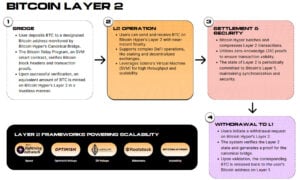The anticipated update to the Bitcoin network, Bitcoin Core v30.0, has been officially released and is available for download to node operators.
According to release notes shared by Bitcoin Core, the update brings performance improvements and bug fixes. However, many devs and Bitcoin supporters are opposing an update to OP_RETURN, which lets users attach data of up to 100,000 bytes (100KB) instead of the previous 83 byte limit.
What are the major changes in Bitcoin Core v30.0?
One of the major updates in Bitcoin Core is lower default fees. Nodes can relay transactions between peers with fees as low as 0.1 sat/vB. Miners, on the other hand, will be able to include transactions in the next block with a minimum fee of 0.001 sat/vB.
OP_RETURN, which lets Bitcoin users attach data, like special messages, has more room to attach data, from 83 bytes to 100KB. OP_RETURN has multiple outputs instead of the previous single output. The increase in data limit lets users attach hashes, certificates, or even art metadata.
Moreover, Bitcoin Core v30.0 no longer supports BDB wallets. Users must migrate to descriptor wallets, which are safer and easier to back up. Wallet commands such as importwallet and dumpwallet are also gone. The update also brings TRUC transactions, which avoid transaction conflicts while they wait for confirmation.
Another new command is bitcoin, which simplifies how node operators and miners interact with Bitcoin Core. Also, typing bitcoin node, bitcoin gui, or bitcoin rpc replaces multiple older commands. Miners can connect directly to Bitcoin Core with an experimental PC Mining Interface, which works through local sockets, making block template requests faster.
The graphical user interface (GUI) received multiple updates as well. The graphical toolkit was updated from Qt5 to Qt6. Dark mode for Windows users is now supported, and on macOS, the Metal graphics are available for smoother performance.
Other updates include fixing five low-severity bugs. The full details of bug fixes will be released within two weeks. Any node operating Bitcoin Core v27.x will no longer receive newer updates since v27.x is now labeled “End of Life” according to release notes from Bitcoin Core.
What’s the controversy about Core v30.0?
The increase of OP_RETURN’s data limit from 83 bytes to 100,000 bytes (100KB) received heavy criticism from developers and Bitcoin supporters. As mentioned above, OP_RETURN now lets users attach more data and allows multiple OP_RETURN outputs in a one transaction.
The Bitcoin Knots community, led by developer Luke Dashjr and Bitcoin Mechanic, opposed the new changes to OP_RETURN.
They argued that increasing the data limit could force node operators to host illegal or harmful content, such as explicit material or malicious code. This could pose legal issues for node operators.
The Knots community believes that Bitcoin should focus on money transfer, not file storage. In contrast, Bitcoin Core developers say the changes only adjust the memory pool (mempool) policy. It will not affect Bitcoin’s consensus rules.
In September, Bitcoin Core developers planned to deprecate user control over the OP_RETURN data limit. That would have forced node operators to accept higher data limits without the option to reduce them.
After backlash, Core maintainer Ava Chow restored user configurability over the data limits just before the October release window. The decision temporarily ended fears of forced settings. But the feature could be implemented in future versions.
The update also changed how the -datacarriersize setting works. In older versions, a number like 83 represented an 83-byte limit, but in v30 the same value allows 9x more data. Critics say this silent change misleads users. For now, v30 keeps the new 100 KB default while still letting users manually lower it.
Is Bitcoin going to fork?
In late September, leaked messages suggested that Luke Dashjr might consider a temporary hard fork of Bitcoin to resist the new OP_RETURN data limit changes.
TheRage claimed Dashjr was exploring a fork to protect node operators from potentially illegal data spreading through the network. But Dashjr denied the claims, calling the reports “fake news.” He said he was not planning any fork and that “there is no hard fork.” Still, he maintained his opposition to the new rules and accused “Core30 apologists” of being the only ones proposing forks.
TheRage publication stood by its reporting, pointing out that neither Dashjr nor his colleagues disputed the authenticity of the leaked messages.
Want your project in front of crypto’s top minds? Feature it in our next industry report, where data meets impact.
Source: https://www.cryptopolitan.com/bitcoin-core-v30-0-released-btc-fork/



